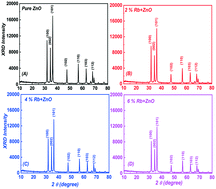Effective role of Rb doping in controlling the crystallization, crystal imperfections, and microstructural and morphological features of ZnO-NPs synthesized by the sol–gel approach
Abstract
This article is dedicated to synthesizing pure ZnO and Rb-doped ZnO nanoparticles, RbxZn1−xO-NPs (x = 0.0, 0.02, 0.04, 0.06 mol), using sol–gel technology. Synthesized samples have been characterized and studied using X-ray diffraction (XRD), energy-dispersive X-ray spectroscopy (EDX), and field-emission scanning electron microscopy (FE-SEM) analysis. The X-ray diffraction study confirmed that RbxZn1−xO NPs have a hexagonal wurtzite polycrystalline structure with the space group C6v4-P63mc. XRD studies showed that increasing the Rb concentration leads to a decrease in the observed intensity of diffraction lines; in addition, these lines are slightly shifted towards lower diffraction angles. The texture coefficient (TC) values, degree of crystallinity values, and crystalline and non-crystalline phase percentages of RbxZn1−xO-NPs were also investigated and discussed via analyzing the area under each diffraction peak. The microstructural parameters (crystallite size, D, and average microstrain, 〈ε〉) of Rb–ZnO-NPs were also determined using the Scherrer equation, the Williamson–Hall (W–H) method, and size–strain plots (SSPs) via applying the Lorentzian distribution (LD) and Gaussian distribution (GD) to compute the net broadening of diffraction lines. Using the GD and W–H methods, which were the best, it was found that the D-values decreased from 50.67 nm to 34.23 nm, while the 〈ε〉-values increased from 1.43 × 10−3 to 3.48 × 10−3 when the Rb content increased from zero to 0.06 mol. The EDX findings demonstrated that the compositional element percentages of the RbxZn1−xO-NP samples are in good agreement with those selected. The particle sizes of these NPs range on average from 60 nm to 700 nm and decrease upon increasing the Rb concentration. Generally, the results confirm that the RbxZn1−xO-NPs obtained using the sol–gel technique are regular and uniform in shape and have fine and smooth surfaces.

- This article is part of the themed collection: Crystal Engineering in Africa


 Please wait while we load your content...
Please wait while we load your content...